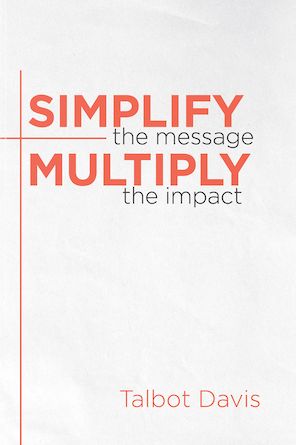Simplify the Message: Multiply the Impact by Talbot Alan Davis
by Rev. Dr. David Mosser on Thursday, July 16, 2020

Simplify the Message: Multiply the Impact by Talbot Alan Davis
When I opened the package and retrieved Talbot Davis' book on preaching, Simplify the Message, at first it seemed to go against most of the notions I had acquired about preaching. I learned some in seminary homiletics classes, but also learned from some of the guiding preaching voices in the 1970s and 1980s.
I mention here Barbara Brown Taylor, Fred Craddock, Eugene Lowry, Samuel Proctor, Tom Long, and others. These persons helped me organize my week into the disciplines of prayer, thought, reading, study, and creativity. In addition to configuring a week to put content together, they also taught me about sermonic form. That is, how does one put sermon elements together that will make sense to the listener, and also persuade listeners to lean forward?
For the above reasons and perhaps several more, I did not initially relish reading Davis’ book, Simplify the Message. After reading the book with care, I now repent in “dust and ashes.” For Simplify the Message had observations on preaching I found stimulating, discerning, and perceptive. Its author is Talbot Davis, pastor of Good Shepherd United Methodist Church in Charlotte, North Carolina, a congregation known for its ethnic diversity, outreach ministry, and innovative approach to worship. Davis has previously written five sermon series manuscripts which Abingdon Press turned into Bible Study books
On first blush, Simplify the Message, appears to be a book for either seminary students or those on their first steps of a preaching journey. Yet, surprisingly the book is full of wise counsel even for those who have preached for decades. Veteran preachers regularly become attached to their favorite/comfortable methodologies. Davis offers both novice and old hand preachers a new point of view by which they can create and analyze sermons.
Davis’ prime intent is to ease preachers from cluttered sermons to sermons offering more clarity. He ardently makes the point that there is great power in making one focused point in a sermon. This idea, of course, is an idea that most notable homiletic theorists would have happily embraced. Yet, over time, it is an easy concept from which to wander. We preachers too often cause sermon clutter by wanting to say more about our subject—perhaps to come across as experts. Or the academic fascination in our pastor’s study makes it so that we just HAVE TO share the minutiae of learning. Or worse, over-preaching clutter is simply filler material.
Davis suggests that the one-point sermon should do three primary things: engage, encounter, and empower. As a sermon summation, at the end should be a “bottom line.” This "bottom line" is simply a striking, memorable sentence that wraps up the sermon’s content. It is a short statement. The aim of this “bottom line” statement is to lodge it in the listener’s mind. Examples: “What you tolerate today will dominate you tomorrow,” “Move on what you are moved by,” “Treat the people you LOVE as well as your treat the people you NEED,” and “Surrender your impulses so you don’t surrender to them.” The “bottom line” neatly wraps up the sermon in a memorable saying—a jingle-like condensation. Davis’ process is formulaic—there is no doubting that fact. Yet, for those who are beginning to preach, this may be a beneficial feature.
The book’s balance flows from the principal of one point and its attendant bottom line. Each chapter builds on another and contributes to Davis’ primary point—one point. These subsequent chapters address exegesis, observing or noticing details from both scripture and human experience, how to shape the sermon experience (sermon form), using words effectively, and how to preach without notes. One of the book’s big surprises for me was that Davis urges preachers to write a full sermon manuscript. Yet, he forbids preachers to take the sermon manuscript into the pulpit. Davis nearly mandates this writing practice as he sees the benefit of power and discipline in this exercise. Simultaneously, he counsels against dragging the manuscript into the pulpit for fear of the temptations it may inspire—the manuscript as safety net.
With respect to content—a last word. Davis preaches only sermon series. This strategy puts him in good stead with a generation of younger preachers. To be fair, he makes the case for as well as against lectionary preaching. But, in the end, he believes series preaching is the best way to keep a congregation engaged. Whether or not this is true, I have noticed in four decades of preaching that good preaching, whether lectionary or preacher’s choice, generally keeps congregations engaged!
I recommend this book as a “soup to nuts” guide to preaching and the work of developing a weekly sermon. It is a book that preachers toward the beginning of their ministry will find helpful—like cooking with a recipe for a novice “chef.” It is a book that veteran preachers will experience as a helper refresher course. All in all, Talbot Davis’ Simplify the Message is worth an afternoon’s read.
Rev. Dr. David Mosser, Senior Pastor, Salado UMC, Salado, Texas
Former adjunct homiletics professor at Perkins School of Theology, SMU
